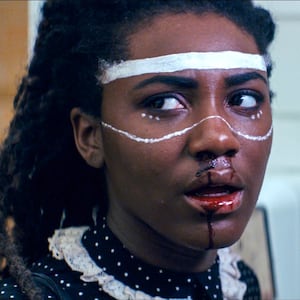When the painter Marianne first encounters a young noblewoman named Héloïse, whom she has been hired to paint without her knowledge, she is met with the back of a billowing black cloak, tense and furious as a storm cloud. Héloïse says nothing before she jolts away—out the door, across wet grass, then straight toward a towering, jagged cliff.
Marianne is at first curious. She must commit her subject’s image to memory, then reproduce it as a wedding portrait for the soon-to-be-husband Héloïse has never met. (Héloïse has foiled other painters’ attempts by refusing to pose, so her mother hires Marianne under the cover of a “walking companion.”) Marianne trails Héloïse’s black hood, our eyes fixed on it through her gaze, as an image reveals itself in parts: first a mop of blonde hair, then a gloved hand. Suddenly, two legs, racing toward the cliff’s edge. Marianne shifts with uncertainty and then panic as she finds herself running in pursuit. Before she’s ever seen Héloïse’s face, she’s compelled to keep her close.
Héloïse stops, wobbling precariously. Finally, she turns to Marianne. “I’ve dreamt of that for years,” she says. Breathless and relieved, Marianne asks if she means death. “Running,” Héloïse clarifies.
The two lovers’ introduction in feminist French auteur Céline Sciamma’s Portrait of a Lady on Fire is the first provocation of the relationship between subject and object. It’s a movie about the gaze—Marianne watches Héloïse, Héloïse watches Marianne watching her, and we and the filmmaker watch them both. As the two women grow closer, those relationships mutate and shift; Héloïse becomes an active collaborator in the painting of her own image. And she challenges Marianne to break from and create outside the conventions of the male gaze, and to imbue her work with her own authentic “presence.”
It’s not unlike what Sciamma and her lead actresses, Adèle Haenel (who plays Héloïse) and Noémie Merlant (Marianne), created with the film, which came away with the Queer Palm and Best Screenplay awards at this year’s Cannes Film Festival. Exquisitely crafted, restrained, and yearningly romantic, it’s among the most singular films of the year, in large part due to Sciamma’s original vision. “I’m trying to make a film about a book that’s never been written,” the writer-director explains. “I’m trying to be a little bit candid, trying to invent the language of the film.” But as it went for Marianne’s art, so it goes for Sciamma: “You have to put up a fight to actually do that,” she says.
The disciplined Marianne studies Héloïse in stolen glances, swallowing up the shape of her ears, her hands, her complexion. Héloïse, meanwhile, is all quiet, glittering rage; she lived in a convent until her sister’s suicide and resents the inevitability of marriage. “I’ve never even seen her smile,” Marianne complains to Héloïse’s mother several days into her assignment. That was a deliberate choice, Sciamma says: allowing the object to feel her anger without softening her for either Marianne’s painting or the camera’s gaze.
The filmmaker understands audience expectations; when two people fall in love onscreen, they often smile and flirt. But in the intense, slow-burn first half of Marianne and Héloïse’s romance, Sciamma says, “they don’t have to.” They are two women isolated together, finding trust and solace in each other. “They concentrate, they share the loneliness. Who would they be smiling to? To the audience?” It was a difficult choice to communicate to others, even on set.
“Even my collaborators who know the film, like my assistant director or the script girl, they were like, ‘Maybe we can do one where they smile, it could be useful.’ But I don’t want to have options. I want to make decisions,” Sciamma says.
The writer-director is seated next to Haenel and Merlant in a room high over Central Park in New York. “It’s not the first time I’ve had this comment on a film I made, that I was not smiling enough,” Haenel adds, recalling her time filming the Dardennes brothers film The Unknown Girl in 2016. “I said, hmm, yeah. But I don’t know when I should smile. It’s funny that it [happened] again.” She is not particularly amused as she says this.
“We never see women not smiling. Never. Even on TV, everybody smiles,” Sciamma says. “So you have to put up a fight not to. You have to put up a fight not to smile in photographs. You have to put up a fight”—a slow grin forms—“not to smile when you’re climbing the stairs in Cannes.”
Haenel plays Héloïse at first with a beguiling sternness, like a pre-code starlet whose glares communicate an unspoken assumption: she doesn’t need you. “With Héloïse’s character, to me, it was like a rebellion,” Haenel says. “I just say, ‘OK, I will do what you want. But don’t you dare believe that you can get close to me.’ This is where I wanted to embody this rebellion, with the fact that my face would not be moving very much. And it’s not only about not smiling. Almost every emotion is very small. There’s not much that [registers] on my face.” Until, of course, there is.
The women’s first exchange of open, genuinely affectionate smiles, in Sciamma’s view, comes with “the bonfire scene, and it’s an hour and 20 minutes into the film.” She’s talking about the movie’s guiding image, in a scene where Héloïse and Marianne lock eyes across a fire. A female chorus raises its voices to a divinely eerie pitch and the two women beam; to them, this is freedom. Héloïse barely notices when the hem of her skirt catches fire. We see her then through Marianne’s eyes: a vision of desire (literally) combusting.
A girl in love on fire is one of the first images Sciamma dreamed up as she wrote the script. It functioned from then on “as a compass for the film. It’s literal, not psychological,” she explains. “She’s not, ooooh, wild. It was just, ‘Let’s go all the way. Let’s set fire to her.’ I think that’s kind of the motto of the film: be simple, straightforward, and bold. The film is quite playful with this.”
Sciamma shot Portrait of a Lady on Fire in a brisk 38 days, starting with exteriors on the island of Brittany then moving to a castle in the Parisian suburbs to shoot the interiors. “We had the time we needed,” she assures me. “There’s only 69 scenes, which is half of the scenes of a traditional script.” The film’s sparseness reflects in its production design and costuming, which prioritize function and economy. “We thought a lot about this, how to not get overwhelmed with the things that are supposed to come with a period piece. You have to compromise and still be able to [execute] our vision,” she adds.
Perhaps remarkably considering their chemistry onscreen, Haenel and Merlant rehearsed none of their scenes together until after they arrived on set. They worked “on instinct” instead, Merlant says. Individual movements and looks were written in the script, but “how you propose to look at her is something you decide, and she looks at me in a way that I don’t know, so it’s always something that we create together,” she says.
Working on Sciamma’s set, with female cinematographer Claire Mathon, among a small cast of mostly women, Merlant says, was something of a revelation. “I realized how I was connected to the male gaze—like I was thinking and acting [according] to this frame of the patriarchy. That is still so real,” she says. “The movie connects us with this and that’s why it’s a vision [that is] really important.”
Sciamma nods. “The male gaze is the convention, but it’s a fake neutral. And we are all raised in it,” she adds. “You can be a female and not deconstruct it at all, and be part of the group and objectify and reproduce the same images. But everybody is able to deconstruct it. Men can stop using the male gaze, women can go on using the male gaze; it’s a political choice. It’s not about psychology or sensitivity.” It isn’t that she condemns the use of the male gaze, she emphasizes. “You can have a lot of pleasure in reproducing those images, and also in receiving them as a viewer. It’s just you have to be aware and make your own choices.”
In the film, Héloïse and Marianne’s camaraderie extends to a third character, Luàna Bajrami’s Sophie. She is a servant, though after Héloïse’s mother leaves for a short time, she becomes something closer to a friend. The three women cook, play cards, and tell stories together, their hands rarely unoccupied by the next task. Soon, that extends to the work of helping Sophie secure an abortion. Their friendship recalls what Héloïse tells Marianne about the “advantages” of life in a convent: “Equality is a pleasant feeling.”

Noémie Merlant, Céline Sciamma and Adèle Haenel attend the 72nd annual Cannes Film Festival on May 25, 2019, in Cannes, France.
Vittorio Zunino Celotto/Getty“I wanted to portray sorority, and this very specific dynamic among women when there’s no more social hierarchy,” Sciamma says. Making Sophie “a character, and not the character of a servant” was imperative. “This kind of utopia is possible, cinema can make it happen because it’s the only place where you can share somebody’s loneliness. Otherwise, if it’s mundane, or in the social world, you will not share their intimacy. You will see a mask.”
Héloïse and Marianne accompany Sophie to her procedure with both curiosity and a softly muted queasiness. When Marianne turns away, Héloïse commands her to bear witness. It’s one the film’s many gestures toward the importance of recording women’s history through art. (Héloïse later pushes Marianne to sketch a recreation of Sophie’s abortion.) “I think Celine uses the period piece to be more accurate about the present,” Haenel says. “History doesn’t exist. I don’t know how to say this. But it’s not a fact. It’s how we choose to say [which] things were relevant in the past.”
Sciamma, who became romantically involved with Haenel after they worked together on her 2014 film Water Lilies, gently rebuffs the first point. “I’m not using the past to talk about today,” she says. “I’m trying to transmit what has not been transmitted, which is our intimacies in the past as women. To create and build memories through cinema.”
Merlant connects it to the suppressed talent of 18th-century female painters like Marianne—who were often barred from attending academies and sketching nude male models—and the rising ranks of female auteurs in France and abroad, Sciamma among them. “Even in this period, there was a flourishing arts feminism and progress, but that was cut [down],” she says. “There was a backlash, and now again we feel there have [been] advances made. I hope it will continue. But we’ll see.”


